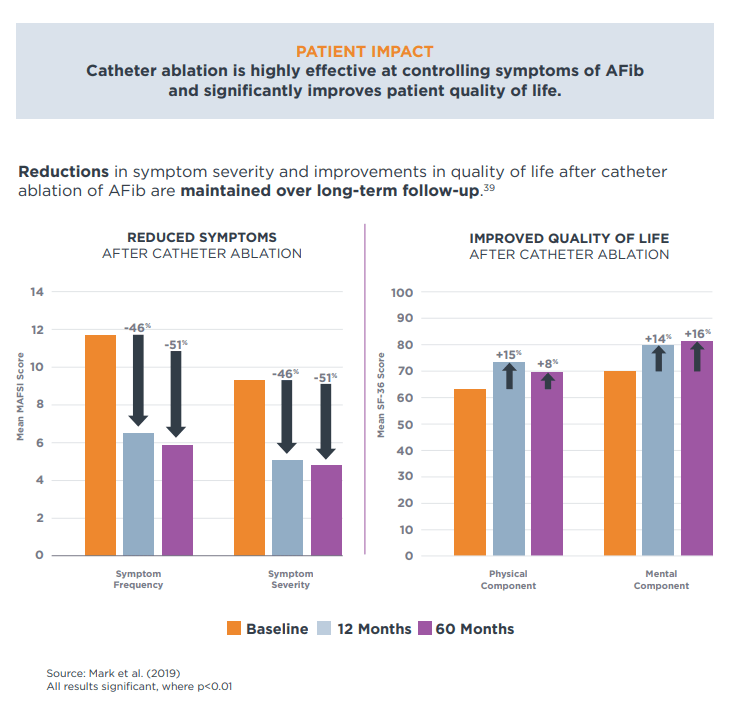This article was sponsored by Biosense Webster

Putting the patient at the centre of the discussion is vital to setting the right strategy for the treatment of atrial fibrillation (AF). This is according to Biosense Webster’s recently published report: Atrial Fibrillation: A Brief Guide to Patient Impact, Disease Management and Treatment Outcomes which summarises the latest data on catheter ablation compared to antiarrhythmic drug therapy.
Anupama Rao, assistant professor, and Parikshit Sharma, associate professor, both of whom work in the Division of Cardiology at Rush Medical College (Chicago, USA) spoke to Cardiac Rhythm News, discussing this report and the importance of considering all treatment options on the table when tackling AF—including balancing the benefits and limitations of antiarrhythmic drug therapy versus those of a catheter ablation-based strategy—and how early intervention can be key to optimising outcomes.
“Atrial fibrillation is such a common diagnosis for our patients,” explains Rao, adding that as a cardiologist, it is among the top one or two diagnoses seen in-clinic. The latest data suggests that as many as 33 million people worldwide are directly impacted by the condition.1 Deciding upon which of the available treatment options should be pursued and how these strategies may fit the needs of the patient are an important first step, she says. “We need to not only consider the patient’s wishes, but also the presence of comorbidities, their particular risk profile, and the potential for adverse effects from antiarrhythmic medications. We really do involve the patient at the centre of everything, with the goal of improving symptoms and reducing stroke.”
Current guidelines covering the management of AF, published jointly by the American Heart Association (AHA), American College of Cardiology (ACC), and the Heart Rhythm Society (HRS) in 2014, recommend an integrated approach to AF management that places patients in a central role in the decision-making process.2 Echoing Rao’s comments, the guidelines dictate that the goal of the initial AF management strategy is to treat any underlying cardiovascular conditions and reduce the risk of stroke. This has historically centred around the use of antiarrhythmic drugs, which are the first-line therapy for AF management and maintaining sinus rhythm.

As an electrophysiologist, Sharma believes that evaluating the individual patient risk profile is paramount to the development of any treatment strategy, whether it be a drug- or catheter-based approach. “When you lay out the treatment options for the management of AF, I think the cornerstone really is the assessment of the risk of stroke that comes along with AF and appropriately anticoagulating these patients if that is indicated,” he says. At this stage, Sharma explains, the physician is faced with determining whether an approach focused on rate control or rhythm control, to manage or maintain heart rate, is desired. “To tease out the symptoms, I think it is important to at least consider rhythm control therapies [such as electrical or pharmacological cardioversion] and reassess if the patient does not notice a benefit,” he says. “If they don’t, you are left with two options, one is an antiarrhythmic drug (AAD) which should be the first-line therapy of choice, or the other is an ablative strategy for patients where AAD therapy was not effective or not well tolerated, to minimise triggers for AF, which can either be catheter based or a hybrid approach.”
Rao adds that antiarrhythmic drug therapy is the first-line therapy choice. However, she acknowledges that there is increasing recognition of the possible benefits of earlier ablation4, particularly in patients for whom antiarrhythmic drugs are less effective, or in those who are experiencing adverse side effects. “I think we, as general cardiologists, should have a lower threshold to refer patients when they are not tolerating these medicines,” she said.
This point is picked up by Sharma, who comments that there is an increasing acceptance that—particularly for symptomatic patients—rate control by itself may not be sufficient to manage the disease. Furthermore, he said, recent research has suggested that earlier referral of patients to a catheter-based rhythm control strategy among those for whom rate control is ineffective, is an optimal and a potentially seismic shift in the way AF is managed. “The natural history of this disease dictates that, as time goes on, it becomes more difficult to control in terms of the maintenance of sinus rhythm,” he said. “It is important to refer these patients for management of AF early. Studies have demonstrated that earlier rhythm control can result in improved outcomes not only when it comes to symptomatic improvements, but also there is a strong signal towards improvement in mortality, quality of life and heart failure hospitalisations.”5

Considering the evolving role of catheter ablation in the management of AF, Sharma comments that catheter-based ablative strategies are continuing to develop, but adds that in an increasing number of cases, this may be the best available strategy. He adds: “Overall, the acute complications related to catheter-based ablative strategies are lower and they are better tolerated than in patients with antiarrhythmic drug therapy strategies, and therefore most patients, particularly younger patients who do not want to stay on medication for long periods of time, really prefer that strategy over antiarrhythmic drugs.”5
Will catheter ablation play a greater role in the management of AF in the future? Sharma believes so. He comments: “After looking through some of the data that has emerged in the last two or three years, such as the CABANA and ATTEST studies, I think we are moving to a point where catheter-based ablation could be a recommended treatment option to delay disease progression. That is where we will see the biggest paradigm shift.”
 With current guidelines stressing the importance of patient involvement in dictating the treatment strategy for AF, both Rao and Sharma believe that patients are entitled to consider how they may benefit from the different available options for addressing the disease. “The patient needs to be at front and centre of all of our discussions,” says Rao, adding that the patient should be considered as being “at the centre” of the multidisciplinary heart team. This is echoed by Sharma who adds: “It is important to recognise that we are here to care for our patients, and that is really where things start and end.”
With current guidelines stressing the importance of patient involvement in dictating the treatment strategy for AF, both Rao and Sharma believe that patients are entitled to consider how they may benefit from the different available options for addressing the disease. “The patient needs to be at front and centre of all of our discussions,” says Rao, adding that the patient should be considered as being “at the centre” of the multidisciplinary heart team. This is echoed by Sharma who adds: “It is important to recognise that we are here to care for our patients, and that is really where things start and end.”
Both Rao and Sharma also agree that in the digital age, being able to provide clear, accurate and digestible information to patients and physicians alike is crucial to ensuring that AF treatment strategies can be truly optimised to the needs of the individual. For more information summarising the latest data on catheter ablation compared to antiarrhythmic drug therapy check out Biosense Webster’s recently published report: Atrial Fibrillation: A Brief Guide to Patient Impact, Disease Management and Treatment Outcomes summarises, that is intended to provide a useful tool in the physician’s toolkit in assessing the available options.
“Physicians and patients really do respond to information that is accurate and depicted in a visually attractive way,” concludes Rao. “This is a very nice report that would serve to educate our cardiologists as well as our patients to make the right decision.”
References
- Khavjou, Olga, D. Phelps, and A. Leib. “Projections of cardiovascular disease prevalence and costs: 2015–2035.” Dallas: American Heart Association (2016).
- January, Craig T., et al. “2014 AHA/ACC/HRS guideline for the management of patients with atrial fibrillation: a report of the American College of Cardiology/American Heart Association Task Force on Practice Guidelines and the Heart Rhythm Society.” Journal of the American College of Cardiology 64.21 (2014): e1-e76.
- Kirchhof P, Benussi S, Kotecha D, Ahlsson A, Atar D et al. (2016) 2016 ESC Guidelines for the management of atrial fibrillation developed in collaboration with EACTS. Eur Heart J 37 (38): 2893-2962.
- Kirchof P, Camm JA, Goette A et al. (2020) Early Rhythm-Control Therapy in Patients with Atrial Fibrillation. N Engl J Med 2020; 383:1305-1316
- Mark DB, Anstrom KJ, Sheng S, Piccini JP, Baloch KN et al. (2019) Effect of Catheter Ablation vs Medical Therapy on Quality of Life Among Patients With Atrial Fibrillation: The CABANA Randomized Clinical Trial. JAMA.
- Paulus Kirchhof, M.D., A. John Camm, M.D., Andreas Goette, M.D., et al. (2020) ‘Early Rhythm-Control Therapy in Patients with Atrial Fibrillation’, New England Journal of Medicine, 383(1), pp. 1305-1316.
- Lafuente-Lafuente C, Valembois L, Bergmann JF, Belmin J (2015) Antiarrhythmics for maintaining sinus rhythm after cardioversion of atrial fibrillation. Cochrane Database Syst Rev (3): Cd005049.
- Hussein A, Das M, Chaturvedi V, Asfour IK, Daryanani N et al. (2017) Prospective use of Ablation Index targets improves clinical outcomes following ablation for atrial fibrillation. J Cardiovasc Electrophysiol 28 (9): 1037-1047
- Jais P, Cauchemez B, Macle L, Daoud E, Khairy P et al. (2008) Catheter ablation versus antiarrhythmic drugs for atrial fibrillation: the A4 study. Circulation 118 (24): 2498-2505.
- Packer DL, Mark DB, Robb RA, et al. Effect of Catheter Ablation vs Antiarrhythmic Drug Therapy on Mortality, Stroke, Bleeding, and Cardiac Arrest Among Patients With Atrial Fibrillation: The CABANA Randomized Clinical Trial. JAMA. 2019;321(13):1261–1274.
- Noseworthy PA, Gersh BJ, Kent DM, et al. Atrial fibrillation ablation in practice: assessing CABANA generalizability. Eur Heart J. 2019;40(16):1257- 1264. doi:10.1093/eurheartj/ehz085.
- Bruggenjurgen B, Kohler S, Ezzat N, Reinhold T, Willich SN (2013) Cost effectiveness of antiarrhythmic medications in patients suffering from atrial fibrillation. Pharmacoeconomics 31 (3): 195-213.
- Nilsson J, Akerborg O, Bego-Le Bagousse G, Rosenquist M, Lindgren P (2013) Cost-effectiveness analysis of dronedarone versus other antiarrhythmic drugs for the treatment of atrial fibrillation–results for Canada, Italy, Sweden and Switzerland. Eur J Health Econ 14 (3): 481-493.
- Akerborg O, Nilsson J, Bascle S, Lindgren P, Reynolds M (2012) Cost-effectiveness of dronedarone in atrial fibrillation: results for Canada, Italy, Sweden, and Switzerland. Clin Ther 34 (8): 1788-1802.
- Weerasooriya R, Jais P, Le Heuzey JY, Scavee C, Choi KJ et al. (2003) Cost analysis of catheter ablation for paroxysmal atrial fibrillation. Pacing Clin Electrophysiol 26 (1 Pt 2): 292-294









